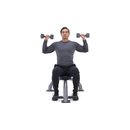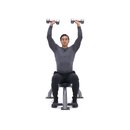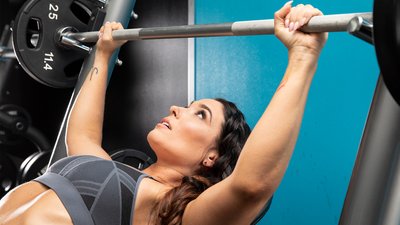Your shoulders are essential to every upper-body exercise, but their extreme mobility leaves them susceptible to injury, especially under heavy loads. To shield the shoulders from damage and move massive weight for the long haul, you have to adopt smart training tactics that stand the test of time.
These powerful pointers from elite strength coaches will help you press more weight and increase your shoulder strength and size. Incorporate these methods into your training regimen to build thick, healthy delts!
Q.What's the best way to safely build shoulder strength and size?
Tony Gentilcore Use A Single-Arm Kneeling Landmine Press
As a strength coach, it's my job to make people stronger and keep them healthy in the long-term. For shoulder training, I live by the mantra that you must earn the right to overhead press.
I recognize there are other exercises to train the shoulders than the overhead press, but I don't find much value in moves like lateral raises, front raises, shoulder burnout sets, or other cute drills. Overhead pressing should be a staple in any training program because it creates a bevy of benefits beyond turning shoulders into cannonballs, but it can be difficult for many trainees.
Most people make the Tin Man look agile, and it's never more apparent than when someone tries to overhead press. Because of stiff or short lats, poor core control and strength, and poor pelvic control and stability, trainees often compensate by hyperextending through the lumbar spine to perform the movement, which causes more harm than good.
As a compromise, I utilize single-arm barbell landmine presses because they're more shoulder- and user-friendly. Single-arm landmine presses offer the benefits of overhead pressing, albeit in a pattern that won't allow cheating or overcompensation.

{{caption}}
Single-Arm Barbell Landmine Presses
I favor the half-kneeling single-arm landmine press for two reasons:
- It takes a few joints (hips and lumbar spine) out of the equation for people with excessive anterior pelvic tilt, which allows the lifter to concentrate on the lift. Because it's performed in the half-kneeling position, it's also a great active hip flexor stretch on the kneeling side.
- There's a significant core, anti-rotation component to the movement because the body has to fight to stay upright throughout the duration of the set.
To perform a half-kneeling single-arm landmine press, follow these simple cues:
- Don't let the rib cage flare out too much or hyperextend the lower back. Pretend there's a line running from your nipple line to your belly button, and don't allow that line to get longer.
- Brace your abs and squeeze the kneeling-side glute as hard as possible. This provides more posterior pelvic tilt and keeps the body in proper alignment.
- Don't allow the elbow to pass the midline of the body or it will cause anterior tilt in the scapulae, which causes more instability in the front side of the shoulder.
- Perform half-kneeling single-arm landmine presses with 3 sets of 6 reps per arm at the beginning of a shoulder workout.
Dean Somerset Stabilize With ITYW Shoulder Raises
The shoulders are incredibly versatile in their movement capability, and they have an insane ability to generate strength through a huge range of motion. These qualities make it very important to spend time working on stabilization. Before any significant loading, it's vital to ensure that the shoulder blades move well to reduce strain on the rotator cuff and other important structures.
One of the best ways I've found to prepare the shoulders prior to a hard workout is to use a basic series called the ITYW shoulder raise that incorporates thoracic extension, scapular stability, and posterior shoulder strength in a variety of positions. It was originally shown to me by James "Diesel" Smith and became a staple within my practices.
The ITYW shoulder raise is an ideal warm-up exercise for the shoulders prior to any significant work. The warm-up alone pumps the shoulders up more than most exercises. If you're brave, try this with 2-5 pound weights in each arm, but don't get too carried away.
Lee Boyce Incorporate Neutral-Grip Positioning
When safety's the name of the game, positioning is everything. If you've got a history of shoulder issues, or your skeletal build doesn't allow you to perform classic shoulder movements like overhead presses and lateral raises without pain, then it's a good idea to change your setup by shifting your hand and arm position.
The proper anatomical position for shoulder work is with the shoulders pulled back and the palms facing forward. (Think of opening a trench coat to show off the goods—your shoulders pull back and your palms face forward.) With this in mind, the safest position for our shoulders is actually the farthest away from the internally rotated position people typically establish when doing the shoulder press, upright row, and lateral raise.
To achieve a safe and stable overhead press position, use dumbbells instead of a barbell, and lift with a neutral grip. Reverse flyes can also be done with a neutral grip so the thumbs point up at the top of the lift. These changes roll the head of the humerus behind the clavicle where it belongs and isolate the deltoids without as much stress or abrasion to the rotator cuff structures.
Shoulder instability is also solved by attacking the upper back for increased strength and size. This helps stabilize the shoulders and tightens the scapular muscles to alleviate pressing problems. Try this workout to improve your own pressing power!

{{caption}}



BodyFit
$6.99/month- 2,500+ expert-created single workouts
- 3,500+ how-to exercise videos
- Detailed workout instruction
- Step-by-step workout tips
- Training at gym or at home
- Access to Workout Plans
- Access to Bodyfit App
- Store Discounts
Already have a Bodybuilding.com account with BodyFit? Sign In

What comes with BodyFit?

- Instructional Videos
Don't risk doing a workout improperly! Avoid injury and keep your form in check with in-depth instructional videos.

- How-to Images
View our enormous library of workout photos and see exactly how each exercise should be done before you give it a shot.

- Step-by-Step Instructions
Quickly read through our step-by-step directions to ensure you're doing each workout correctly the first time, every time.
Todd Bumgardner Warm Up The Shoulder Girdle
Heavy pressing exercises make the shoulders grow because they load the shoulder girdle muscles more than deltoid raise variations. The problem is that the shoulder girdle isn't designed for heavy pressing—it's made for pulling and hanging. The trick to safely build big, strong shoulders is to have the raw materials in place before loading.
If the shoulder joints and thoracic spine don't have the requisite mobility to handle heavy pressing, then you set yourself up for shoulder injury. The same goes for shoulder stability. If you can't control the intensity of heavy pressing, then you should dial it back.
I can't, in good conscience, offer you a strategy to safely attack your shoulders without knowing anything about your shoulders. Your past training, structural makeup, and injury history all contribute to how your shoulders must be trained. If you're committed to training, spend the dough and have an expert check you out.
If you have any doubts, press with dumbbells, kettlebells, and your bodyweight. Once you can properly handle a loaded barbell, use this warm-up to prepare your shoulders for battle.

BodyFit
$6.99/month- 2,500+ expert-created single workouts
- 3,500+ how-to exercise videos
- Detailed workout instruction
- Step-by-step workout tips
- Training at gym or at home
- Access to Workout Plans
- Access to Bodyfit App
- Store Discounts
Already have a Bodybuilding.com account with BodyFit? Sign In

What comes with BodyFit?

- Instructional Videos
Don't risk doing a workout improperly! Avoid injury and keep your form in check with in-depth instructional videos.

- How-to Images
View our enormous library of workout photos and see exactly how each exercise should be done before you give it a shot.

- Step-by-Step Instructions
Quickly read through our step-by-step directions to ensure you're doing each workout correctly the first time, every time.




